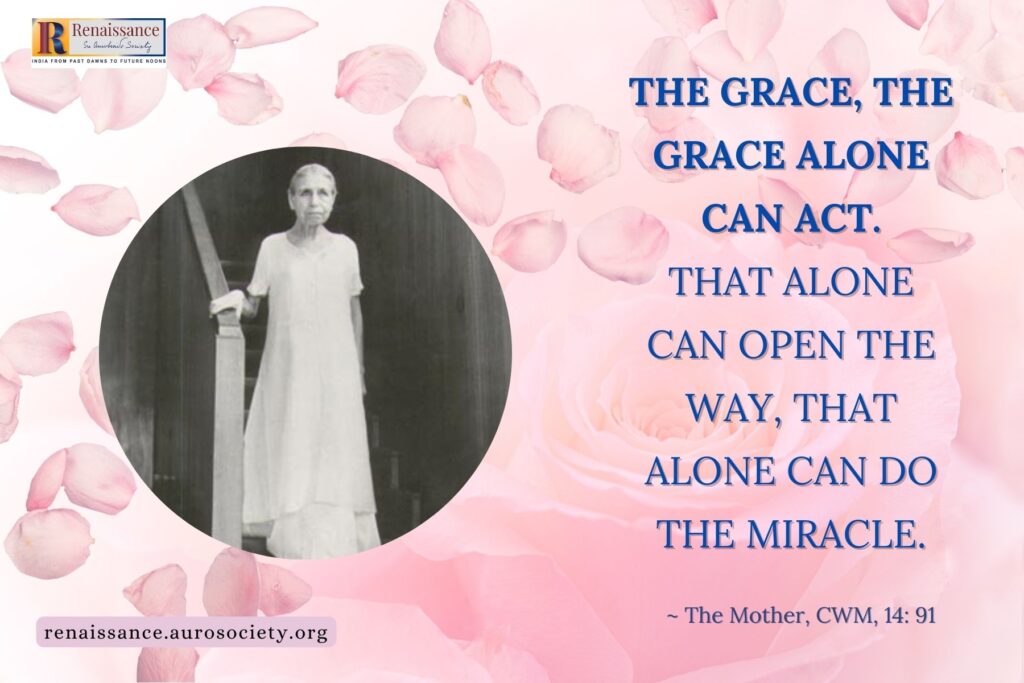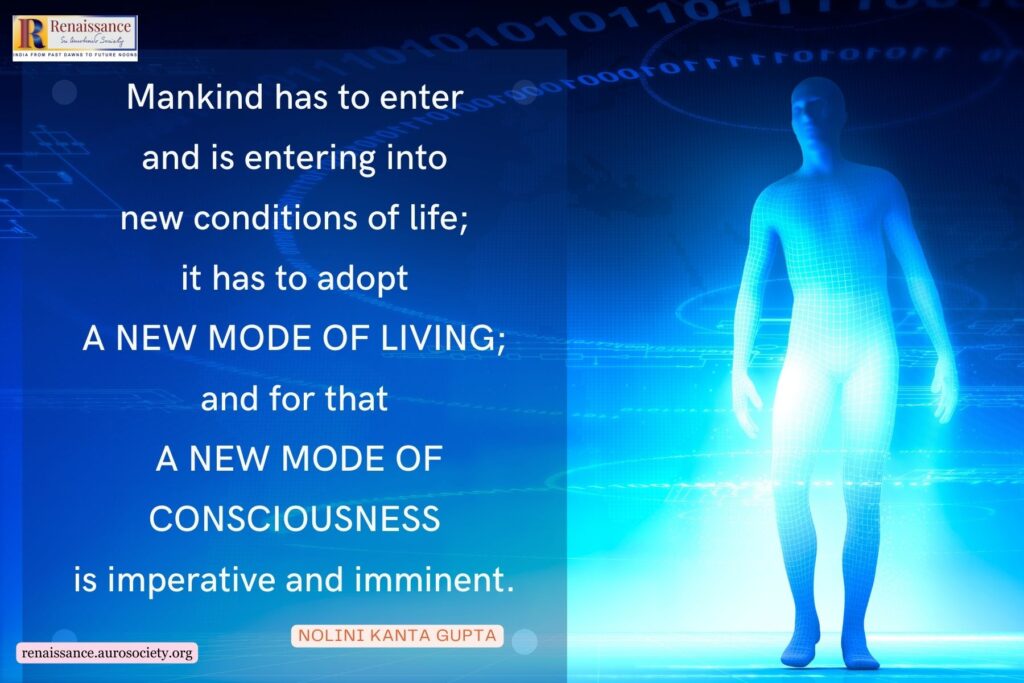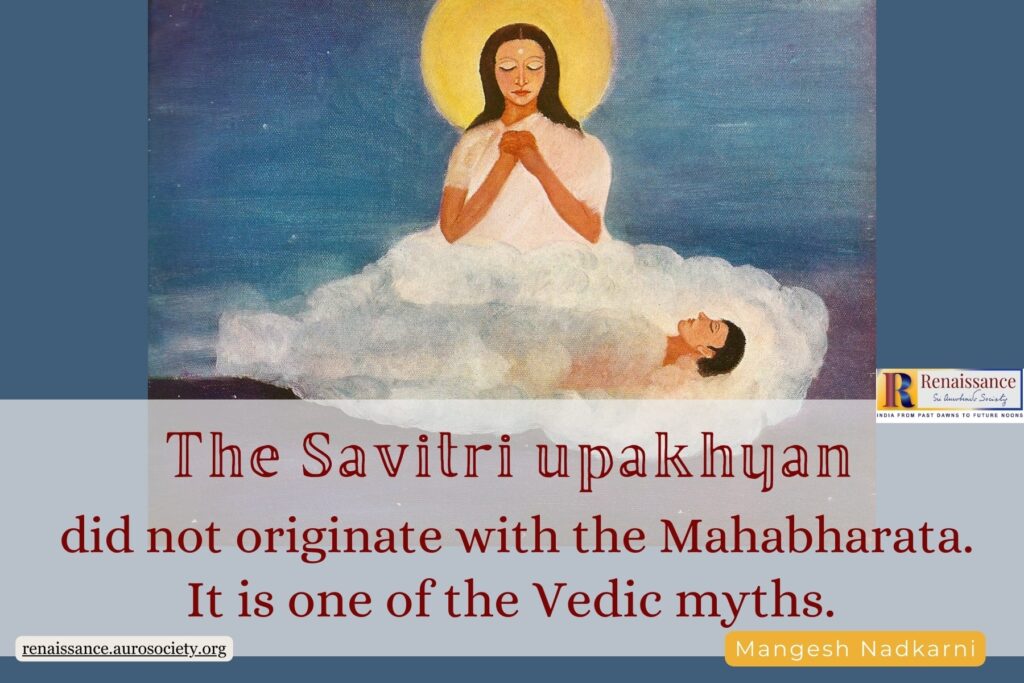Continued from PART 4
Savitri
Sri Aurobindo’s supreme yogic and poetic testament, Savitri was begun during his stay at Baroda. That was the time he experimented with various secular legends and indited narrative poems on some of their characters like Ruru, Urvasie and Savitri. His fascination for the Savitri-legend was recorded in his Notes on the Mahabharata, where he says that the story of Nala and Savitri belong to “the very morning of Vyasa’s genius”, though “the Savitri is a maturer and nobler work” (CWSA, Vol. 1, p. 311).
In the Savitri what a tremendous figure a romantic poet would have made of Death, what a passionate struggle between the human being and the master of tears and partings! But Vyasa would have none of this; he had one object, to paint the power of a woman’s silent love and he rejected everything which went beyond this or which would have been merely decorative. We cannot regret his choice.
There have been plenty of poets who could have given us imaginative and passionate pictures of Love struggling with Death, but there has been only one who could give us a Savitri.
~ Sri Aurobindo, CWSA, Vol. 1, p. 313
Sri Aurobindo seems to have returned to the Savitri theme in his early Pondicherry years. One of these versions had two Parts, Earth and Beyond. But not quite satisfied, he took it up again and again, and at last in the thirties and forties subjected it to further and often exhaustive revisions, from ever higher levels of inspiration and articulation. And the final touches were still being given shortly before he left his physical body on 5 December 1950.
The version as we now have it is an epic of nearly 24000 lines in blank verse, spread over twelve Books.
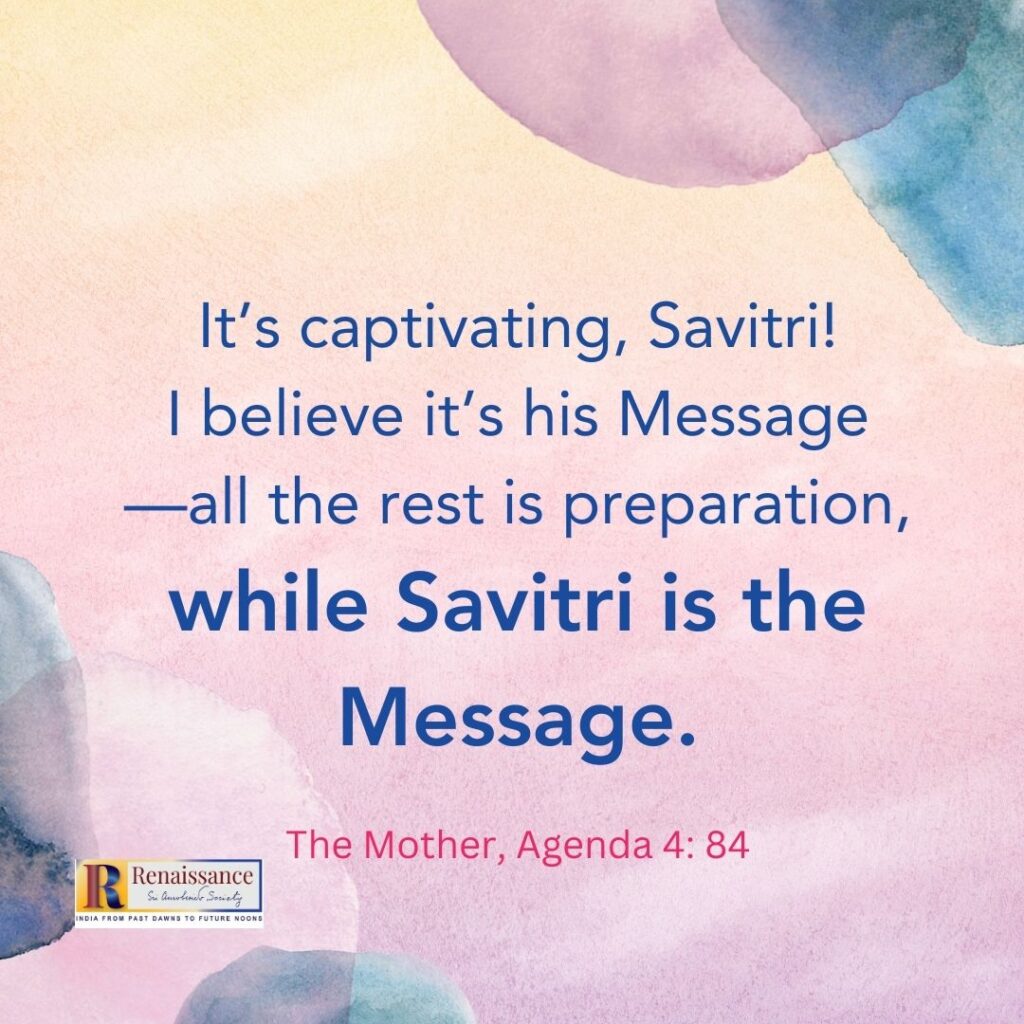
The Upakhyana of Vyasa occurs in the Vana Parva (cantos 291 to 297). Aswapathy, the high-souled king of Madra prays to goddess Savitri for a child and is blessed with a daughter. The child grows up as Savitri, a maiden of divine beauty and wisdom. She chooses Satyavan as her life’s partner, although Rishi Narad tells her that the young man has only one year to live. She strengthens herself with a tri-ratra vrata, follows Yama when he takes away Satyavan’s soul and wins back her husband by pleasing words of wisdom spoken to Death.
Sri Aurobindo has enlarged in his massive epic-recordation the 700 slokas of the Upakhyana. He perceived the symbol behind the secular legend, and with a sage’s vision saw that Savitri is to be the redeemer of the entire humanity (bhartuh kulam as Yyasa refers to it).
To unravel the symbol in the legend, Sri Aurobindo delineates in luxuriant detail the growth, quest and marriage of Savitri. The story is Vyasa’s in all the essentials. But there are also additional imaginative flights, and three major changes. The first of these relates to Aswapathy.
Vvasa refers to an eighteen-year period of austerities (niyama) observed by Aswapathy to obtain a heir.
Sri Aurobindo finds enormous significance in this niyama, which is now projected as Aswapathy’s yoga. The experiences of the king as seen and recorded by Sri Aurobindo are supra-normal. He draws upon the Vedas, the Upanishads and his own yogic experiences to write this Book of 15 cantos. In fact, Aswapathy’s yoga and the Goddess Savitri’s boon, which take about ten verses in the Upakhyana, occupy almost half of Sri Aurobindo’s epic, which means almost a thousand-fold expansion!
In the course of his yoga, Aswapathy traverses the world-stair which contains gross and subtle matter, the kingdoms of the little and greater life, the ineluctable regions of the soul, the heavens of the ideal, the worlds of the mind, the depths of hell and the spheres of heaven. In spite of despairs and disappointments, hope sustains the King, and when at last the Divine Mother appears before him, he requests her for an incarnation to hasten and complete the evolutionary adventure on the earth:
Let thy infinity in one body live,
~ Sri Aurobindo, CWSA, Vol. 33, p. 345
All-Knowledge wrap one mind in seas of light,
All-Love throb single in one human heart. . .
Pack with the eternal might one human hour
And with one gesture change all future time.
The Divine Mother’s gift is Savitri, who grows up and marries Satyavan in spite of the forecast of doom.
She prepares herself to face Death. Vyasa’s tri-ratra vrata — fasting, standing day and night, offering libations to the fire, saluting the elders — blossoms here into the extraordinary Book of Yoga, which describes her quest for her soul, her entry into the “inner countries”, her meeting with the triple soul-forces and her ultimate finding of her true soul and the Soul.
In the process there is a meaningful exploration of hidden realms of consciousness and a confrontation of apocalyptic visions, all with their analogues in Veda and Upanishad and with ample corroboration from Sri Aurobindo’s and his spiritual collaborator the Mother’s own yogic strivings and realisations. Understandably enough, this part of the epic contains nearly 4000 lines.
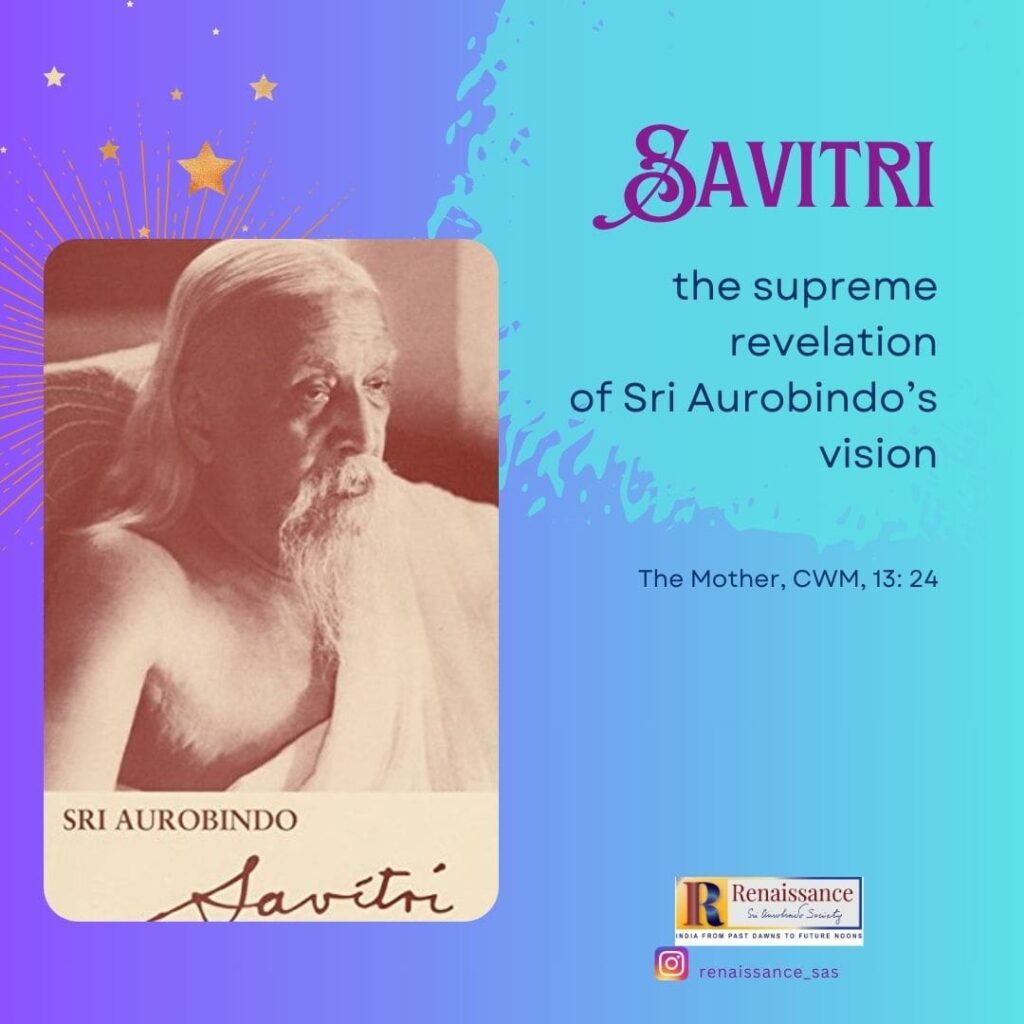
Finally, there is the confrontation of Death and Savitri.
In Vyasa, Savitri pits her strength of chastity against the law of predestination. Her speeches to Yama are a strange mixture of naivety and subtlety and even a little ambiguity. There is neither pleading nor defiance. Yama is polite, kind, understanding. He willingly gives the young Princess several boons. As they converse further, he exclaims:
As often as you speak good words of great meaning which dealing with righteous conduct, are pleasing to the mind, so often do I have a feeling of supreme reverence for you. Ask for a unique boon, O chaste lady!”
The ‘apratimam varam’ Savitri wishes for is “let this Satyavan live” (jeevatu Satyavan ayam). Yama grants the boon and the couple return to their people for leading a life of fulfilment.
This deathless scene in Vyasa is elaborated by Sri Aurobindo into three Books — The Book of the Eternal Night, The Book of the Double Twilight and The Book of Everlasting Day — to work out in poetical and psycho-spiritual terms the struggle that an incarnation has to go through, and the victory for humankind that is achieved. The struggle is between Night and Day, the forces of regression and Progress, between Inconscience and evolving life. Death is the great Negation that taunts man at every turn:
Something stood there, unearthly, sombre, grand,
~ Sri Aurobindo, CWSA, Vol. 34, p. 574
A limitless denial of all being
That wore the terror and wonder of a shape.
In its appalling eyes the tenebrous Form
Bore the deep pity of destroying gods;
A sorrowful irony curved the dreadful lips
That speak the world of doom.
And Death can tempt, taunt, frighten, mock: do anything to render man nerveless, spineless, self-deficient, cynical.
But Savitri symbolises all the strength that can offer battle to this Darkness:
Her high nude soul,
~ Sri Aurobindo, CWSA, Vol. 34, p. 581
Stripped of the girdle of mortality,
Against fixed destiny and the grooves of law
Stood up in its sheer will a primal force. . .
A columned shaft of fire and light she rose.
Just when it appears that nothing can daunt Death’s grip on life and love, the Mighty Mother in Savitri becomes visible:
In a flaming moment of apocalypse
~ Sri Aurobindo, CWSA, Vol. 34, p. 664
The Incarnation thrust aside its veil.
Death is destroyed by this blaze of Truth-Light. Savitri rejects the Supreme’s offer of eternal life in Heaven and returns with Satyavan to the earth to continue the work of transforming life on earth into the life divine.
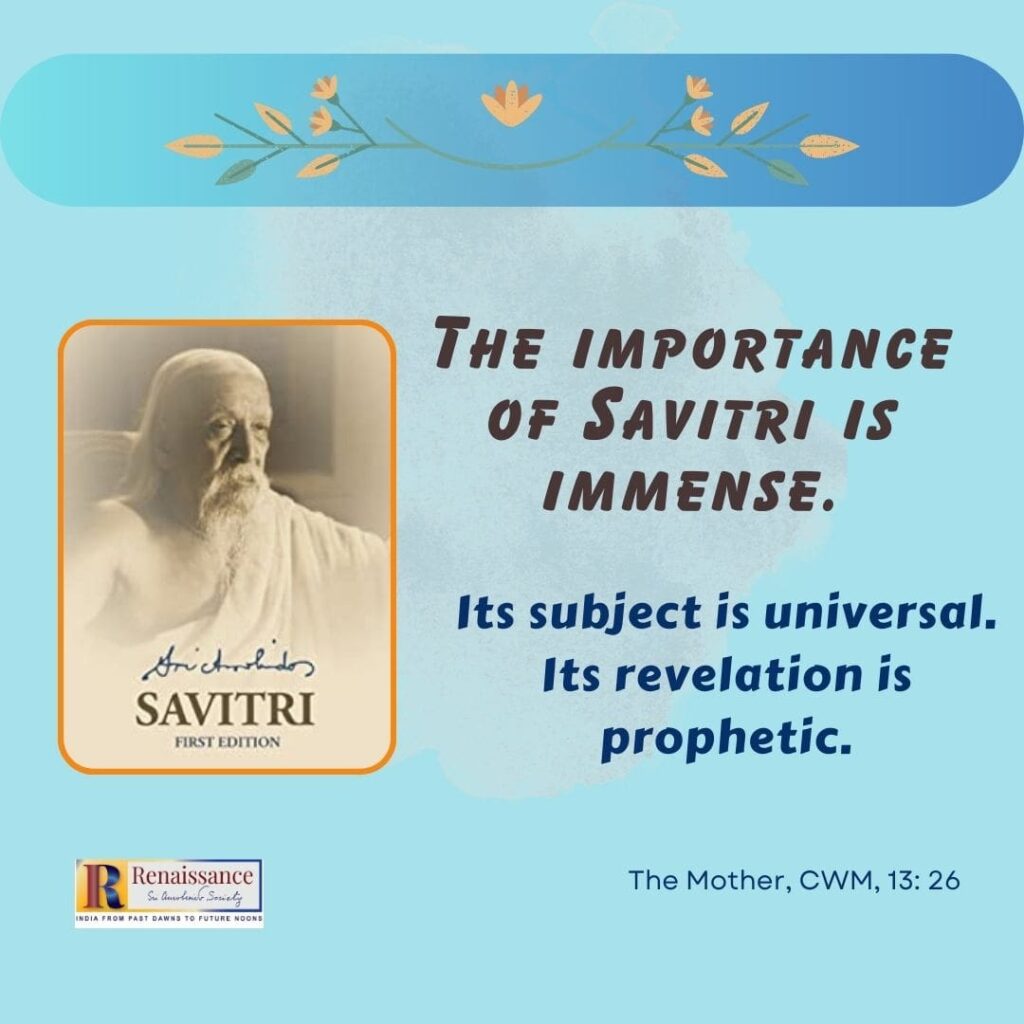
Apart from following Vyasa’s Upakhyana closely, Sri Aurobindo has also taken up Vyasa’s view of the various characters. This is particularly true of Savitri who is no amazon in Vyasa, but a symbol of silent strength. She is ‘kanya tejasvini‘ (glorious girl), ‘rajivalocana’ (lotus-eyed), ‘devakanya’ (divine girl), ‘jvalantīmiva tejasa’ (shines with divine radiance), ‘kasthabhuteva laksyate’ (looks like a block of wood), ‘tapasvini‘ (austere lady), ‘mahavrata’ (lady who had fulfilled a great vow), ‘yasasvini’ (renowned lady), ‘vipulaksana’ (one with wide eyes), ‘pativrata’ (devoted to husband), ‘taponvita’ (lady of austerities), ‘bhadra’ (auspicious maid), ‘sumadhyama’ (lovely one) and ‘sadhvi‘ (good lady).
Sri Aurobindo’s epic rises to the overhead level automatically when he describes Savitri’s power and personality in terms anticipated partly by Vyasa’s glorious epithets strewn all over the Upakhyana.
As Vyasa thousands of years ago, Sri Aurobindo too projects a divine-human power that symbolises a union of beauty and grace, strength and silence:
Near to earth’s wideness, intimate with heaven,
~ CWSA, Vol. 33, pp. 14-16
Exalted and swift her young large-visioned spirit
Voyaging through worlds of splendour and of calm
Overflew the ways of Thought to unborn things.
Ardent was her self-posed unstumbling will. . .
At once she was the stillness and the word,
A continent of self-diffusing peace,
An ocean of untrembling virgin fire:
The strength, the silence of the gods were hers.
As Vyasa’s Gautama, Sri Aurobindo’s Narad too sees her as the Supreme Mother. He tells Aswapathy:
A greatness in thy daughter’s soul resides
~ CWSA, Vol. 34, p. 457
That can transform herself and all around.
Indeed, in the moment of crisis, Savitri stands on the brink of the world, alone, unhelped, and wins the god-like game for man by getting released from Death “the world’s soul called Satyavan”.
TO BE CONTINUED. . .
Read: PART 1, PART 2, PART 3, PART 4
Click HERE for the four-part series on the Ramayana.
~ Design: Beloo Mehra

